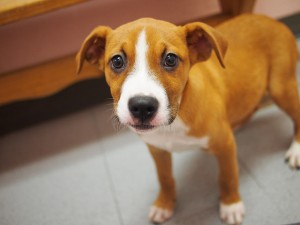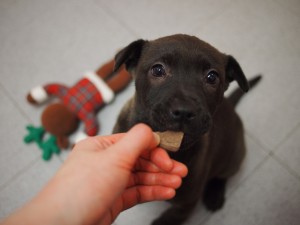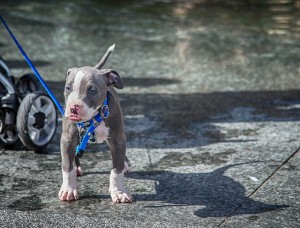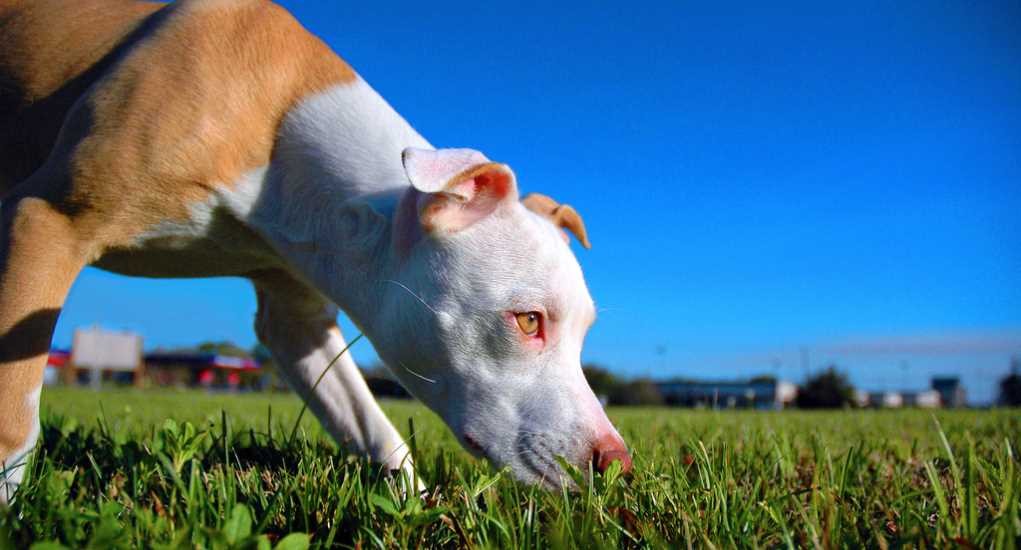The big day has come and you are full of excitement – you are finally going to adopt a cute little puppy! It's very likely that you have spent nights and days dreaming about just the right breed and finding the perfect name for the puppy. Now it is time to bring her home.
So how do you prepare for puppy adoption? What arrangements do you need to go through in order to ensure a comfortable and appropriate home environment for your new family member? Let's talk a little about adopting not only the right puppy, but also the right attitude towards dog adoption and how a new owner needs to prepare for the big day.
First of all, remember that a lot of understanding will be required from your part. Your new four legged pal will most likely have gone through some stress because she was separated from the family, friends and is moving into a new place with lots of new people. Prepare to be forgiving, because your pooch will make mistakes and not always follow your directions. It's normal for a young dog, and positive reinforcement is the only way to teach a puppy how to behave in her new home.
RELATED: Puppy training 101 – Basic walkthrough
Begin by allowing your pet to explore. Let her sniff around, relieve herself in the backyard and run around the place to get to know the surroundings. Young pups are adventurous, which is one of the cutest, most interesting things about them. If you're a parent, have your pooch meet the kids as soon as possible, preferably at the shelter even before you make a final decision to adopt a dog.
Let's talk about preparation for arrival of a new puppy.
Necessary dog supplies for first-time puppy owners

We have previously wrote an extensive article on must-have dog supplies every dog owner should look into, but there are a few things that a young dog won't need and some that she will. In this post, this is exactly what we're going to cover.
Ideally, before the big day arrives, you should have already laid in all of the dog supplies you will need. Do not leave this until the very last moment, and especially until the dog is already home. Prepare in advance, and if you haven't already, make a quick order of dog products from Amazon before you go to pick up your puppy.
RELATED: How to housebreak a puppy effectively
Your dog supplies shopping list will depend a lot on your budget; there's always more things available for the dog than we can afford. For example, dog car seats would be a great idea for her pet's first car travel trip from the shelter back to your house. However, this isn't a necessity yet, so if you're on a tight budget, hold off on purchasing things like dog car seats, dog pools or dog grooming clippers. These are all important, but not urgent.
Preparing: Dog food and bowls

To start, you will need bowls for your pet's food and water.
Consider the size of your puppy before you purchase dog bowls so you can be sure she can reach her food and water. A lot of pet owners also grab a plastic tray to place under those pet food bowls to prevent any constant water spills or dog foods falling on your hardwood floor. It's true – puppies are messy eaters, so it is best to be prepared.
Make sure you also stock up on puppy food in advance, and purchase at least a few days' worth of dog food.
Be aware that if you choose to feed your puppy a brand they are not used to, they may have upset stomachs; it takes a while for the dog to get used to new dog food brands. It may be easier for both of you if you purchase the same food she is used to eating, but you also need to consider whether that pet food is good for a young dog.
For the trip: Dog leash, collar and carrier

You will need to bring a pet collar and leash with you to pick up your puppy.
It is best to use a regular dog leash and not a retractable one until your puppy is used to walking on a leash. When you take a puppy from the shelter, the staff will help you with the leash, so you don't have to worry about knowing how to do this in the beginning.
RELATED: How to teach a dog to walk on a leash
In addition, you may also want to bring a plastic carrier for the car ride. Remember, this is a new dog who's not familiar with the changing environment and the whole world in general. So unless someone will be going with you to pick up a puppy (which is very advisable) and who can hold onto the puppy, you must have a dog carrier with you. This is for everyone’s safety.
For the home: Dog toys and crates

At home, you pretty much MUST have a dog crate waiting for your puppy if you want to avoid potential behavioral problems.
The reason being is that using a good dog crate can help you in many ways when training, teaching and housebreaking your pooch. Also, your puppy will feel safer if he/she has a spot just for her – dogs love having their own dens they can call their actual home.
For a puppy coming into a new home is scary and she will need a place to relax. Usually, dog crates serve this purpose the best, but depending on your financial situation you can also purchase a dog bed or even a dog couch for extra comfort and place it either into the crate, or have it as a separate spot for your puppy. If you're strapped for cash, even old blankets will work just as well in a dog crate as they can be moved around and washed easily. You will also need the crate as a place to confine your puppy when you are gone and as you housebreak her.
RELATED: Top 5 best soft sided dog crates for puppies
Purchase a few great puppy toys ahead of time. Puppies love to chew a lot and unless you want your shoes and furniture to be destroyed in the matter of hours, provide the young dog with safe alternatives that can help her with teething. Use positive reinforcement to properly train your puppy to switch from furniture and other bad chewing habits onto dog chew toys.
For security: Pet ID tags and microchipping

After you brought your puppy home and have chosen a name for the dog, purchase a pet ID tag for her collar that has your name and phone number on it in case she ever runs away, gets lost or is stolen.
This is an important part to ensure canine's safety, and the one that must be addressed within a few days after adopting a puppy.
The next step after you have purchased dog ID tags is injecting a microchip under your dog's skin. All you have to do is take your puppy to a local vet clinic (which you will do eventually anyway, and preferably as soon as possible), pay about $50 and it will take seconds to go through this process.
Louise Murray, DVM, explains what microchipping is:
“A needle is used to place a little chip under the animal’s skin, usually between the shoulder blades. That chip has a unique number on it that can be picked up and read by a scanner. It can be done to lots of different animals, including horses, dogs, cats, ferrets, and most other mammals.”
According to SAWA, only about 20% of lost dogs are ever returned to their rightful owners. The number is obviously not high enough, therefore, having your dog wear a dog collar with pet ID tags is vital. Same goes to microchipping your puppy for extra security and safety in case of a disaster.
Welcoming a puppy into her new home

Your pooch will probably be very excited and nervous when you get her home, so be ready to spend a lot of time with her right away.
You need to make the dog comfortable, and that takes work and patience. Some puppies will want to sniff every inch of the house, while others want to just sit and take it all in before they explore. Give your puppy time to adjust, get comfortable, learn the place and then introduce him to other pets and family members.
RELATED: How to choose the right puppy toys by age
Young dogs can't hold it in for too long, so your puppy will need to go outside often, especially as you begin to housebreak her. She will not tell when she needs to go, so you must be proactive in this and constantly monitor your pooch if you don't want to continue cleaning up after her. Take her out as soon as you get up in the morning and as often as possible during the day, especially after she eats or drinks anything. There are many techniques on housebreaking, so learning effective training methods will pay off big time.
The first few nights at home will be long ones for you and your puppy.

Choose a spot for your puppy to sleep and place her soft dog crate there the first night. She may cry for you so be ready to go to her and comfort as best you can.
Unless you plan to stay awake all night, it is best for her to sleep in a confined area until she is older, no matter how pitiful she may sound as she whines. Not only will this save you a messy house, but it is safer for the dog as well.
You will need to begin your puppy's training routine as soon as you bring her home. While she may not need to know how to shake right away, you will want your puppy to begin to come when you call and to sit on command.
Again, all of this is for her safety. When you take her out on a leash, gently keep her beside you and do not let your puppy lead you. Start right away showing her that you are in charge here.
When you are training your puppy, remember that positive reinforcements work much better than negative ones. Every time you catch your puppy doing something right – whether it is using the bathroom outside or walking beside you – praise her and use plenty of physical reinforcement. Rubbing her belly or scratching behind her ears are great ways to show your puppy you are happy with what she did.
The most important thing you need to do when you bring your puppy home is to spend plenty of time with her until she gets used to the place, new things, new people and even yourself. If at all possible, bring the puppy home when you can spend a few days with her, such as a Friday afternoon, or possibly take a couple of days off work. Always be patient with the puppy and know that her primary aim is only to please and love you.













